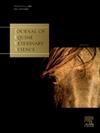Clodronate disodium did not impact tuber coxae microarchitecture or bone mineral density in juvenile horses
IF 1.6
3区 农林科学
Q2 VETERINARY SCIENCES
引用次数: 0
Abstract
Bisphosphonates, including clodronate disodium (CD), are a class of pharmaceuticals that reduce bone resorption. Despite lack of scientific evidence, anecdotal, extralabel use of CD in young animals occurs, aiming to prevent conditions of bone loss or inflammation during training. The objective of the study was to determine the effects of CD on bone microarchitecture and bone mineral density (BMD) in juvenile horses. The hypotheses were that horses receiving CD would have thicker trabeculae with higher BMD. To test the hypotheses, 32 yearling Quarter Horses were stratified by age (500 ± 13 d), BW (336 ± 26 kg), sex (n = 16 geldings, n = 16 fillies), and initial bone optical density, and randomly allocated to one of 4 treatment groups for a 168-d trial. Treatments groups included control (CON; n = 8), single dose of CD (1X; n = 8; d 84), 2 doses of CD (2X; n = 8; d 0, 84), and 4 doses of CD (4X; n = 8; d 0, 42, 84, 126). On d 0, 42, 84, and 126, horses received either 1.8 mg/kg BW CD (OSPHOS®) or isovolumetric saline according to treatment assignments. Horses were housed in individual stalls (3.7 × 7.3 m), fed 1% BW/d concentrate, and allowed ad libitum coastal Bermudagrass hay and water. Horses exercised 5 d/wk in a freestall exerciser using a phase-based progressive workload to mimic sales prep and early training. Biopsies were performed using an oscillating saw to collect samples of the tuber coxa (TC) from each animal on d 84 (left TC only) and d 168 (left, ipsilateral TC; right, contralateral TC). Samples underwent micro-CT (microCT; Quantum GX, PerkinElmer Inc.). Microarchitecture, including bone volume fraction (BV/TV), trabecular separation (TbSp), trabecular thickness (TbTh), trabecular number (TbN), trabecular connectivity density (ConnD), and BMD, were quantified using Dragonfly software (Comet Technologies Canada Inc.). Data were analyzed using PROC MIXED of SAS for the main effect of treatment within each biopsy site. There were no treatment differences for BMD in any TC samples, and there were no treatment effects on bone microarchitecture on d 84 or in the ipsilateral TC on d 168. In the d 168 contralateral TC, there were tendencies in BV/TV (P = 0.09) and TbTh (P = 0.07), where BV/TV was higher in 1X than CON and 4X, and TbTh was higher in 1X than other groups. The tendencies for BV/TV and TbTh were likely driven by one horse in 1X with higher values and are not likely indicative of true population differences. The results led to rejection of the hypotheses, indicating the administered doses of CD had no effect on TC microarchitecture or BMD in juvenile Quarter Horses.
氯膦酸二钠对幼马的茎状骨微结构和骨密度没有影响
双膦酸盐,包括氯膦酸二钠(CD),是一类减少骨吸收的药物。尽管缺乏科学证据,但在幼龄动物中使用乳糜泻的情况时有发生,目的是防止训练期间的骨质流失或炎症。本研究的目的是确定CD对幼年马骨微结构和骨密度(BMD)的影响。假设接受CD的马的骨小梁较粗,骨密度较高。为了验证假设,将32匹马按年龄(500±13 d)、体重(336±26 kg)、性别(n = 16匹,n = 16匹)和初始骨光密度进行分层,随机分为4个处理组,进行为期168 d的试验。治疗组包括对照组(CON;n = 8),单剂量CD (1X;n = 8;84 d), 2剂CD (2X;n = 8;d 0,84)和4剂CD (4X;n = 8;[D] 0,42, 84, 126)。在第0、42、84和126天,根据治疗分配,马接受1.8 mg/kg体重的CD (OSPHOS®)或等体积生理盐水。马被安置在单独的马厩(3.7 × 7.3 m)中,饲喂1%体重/天的精料,并允许随意使用百慕大草干草和水。马在自由式锻炼器中每周锻炼5天,使用基于阶段的渐进式工作量来模拟销售准备和早期训练。在第84天(仅左侧TC)和第168天(左侧同侧TC),使用振荡锯收集每只动物的块茎coxa (TC)样本;右,对侧TC)。样品进行微ct扫描(microCT;量子GX,珀金埃尔默公司)。采用Dragonfly软件(Comet Technologies Canada Inc.)对骨体积分数(BV/TV)、骨小梁分离(TbSp)、骨小梁厚度(TbTh)、骨小梁数(TbN)、骨小梁连通性密度(ConnD)和骨密度进行量化。使用SAS的PROC mix分析每个活检部位治疗的主要效果。任何TC样品的骨密度没有处理差异,并且在第84天和第168天对同侧TC的骨微结构没有影响。168例对侧TC有BV/TV (P = 0.09)和TbTh (P = 0.07)的趋势,其中1X组BV/TV高于CON和4X组,TbTh高于1X组。BV/TV和TbTh的趋势可能是由1X中的一匹马驱动的,其值较高,不太可能表明真正的群体差异。结果导致假设被拒绝,表明给予剂量的CD对幼马的TC微结构或BMD没有影响。
本文章由计算机程序翻译,如有差异,请以英文原文为准。
求助全文
约1分钟内获得全文
求助全文
来源期刊

Journal of Equine Veterinary Science
农林科学-兽医学
CiteScore
2.70
自引率
7.70%
发文量
249
审稿时长
77 days
期刊介绍:
Journal of Equine Veterinary Science (JEVS) is an international publication designed for the practicing equine veterinarian, equine researcher, and other equine health care specialist. Published monthly, each issue of JEVS includes original research, reviews, case reports, short communications, and clinical techniques from leaders in the equine veterinary field, covering such topics as laminitis, reproduction, infectious disease, parasitology, behavior, podology, internal medicine, surgery and nutrition.
 求助内容:
求助内容: 应助结果提醒方式:
应助结果提醒方式:


